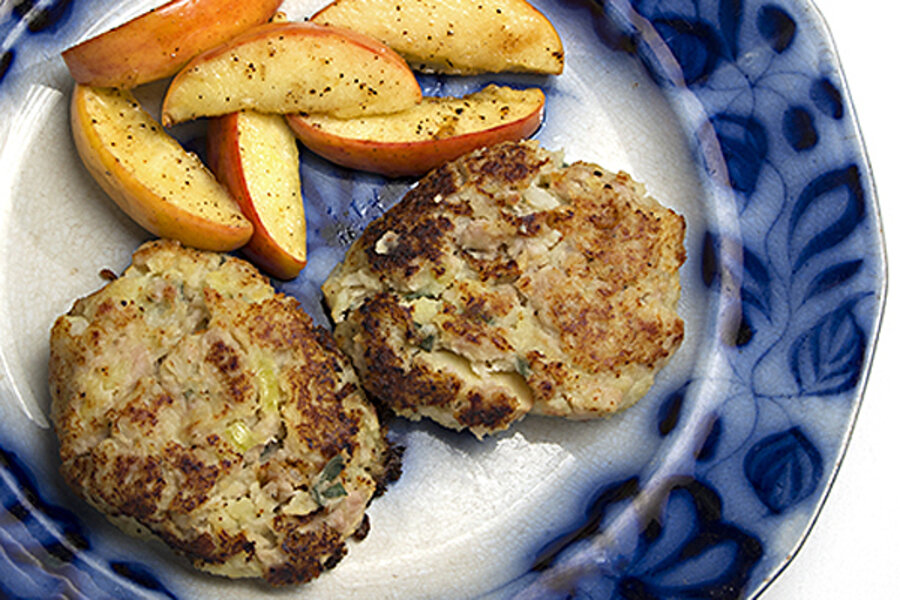Two Irish cookbooks, one hearty weeknight meal: Pork and potato cakes
Loading...
As St. Patrick’s Day approaches, revving up America’s love of all things Irish, two cookbooks celebrate Ireland’s culinary heritage in very different ways. The first is "Irish Pantry: Traditional Breads, Preserves, and Goodies to Feed the Ones You Love," published last November by Running Press. Chef/restaurateur Noel McMeel and writer Lynn Marie Hulsman have teamed up to deliver foods steeped in Irish tradition.
McMeel grew up cooking on his family’s small dairy farm in Ireland and developed a passion for food early on. His recipes are generations old, passed from his grandmother to his mother, to him and to the next generation. He worked under Alice Waters at Chez Panisse and has cooked for the world renowned James Beard Foundation in New York five times. McMeel is now executive head chef at Lough Erne Resort in Northern Ireland, where he cooked for the 2013 G8 summit.
"Irish Pantry: Traditional Breads, Preserves, and Goodies to Feed the Ones You Love" is not about cooking entire meals. Rather, it’s about creating your own Irish pantry of traditional ingredients from which delicious snacks, treats, desserts, homemade food gifts can emerge. You’ll find recipes for everything from jams to cakes, breads, condiments, cookies, spice rubs, porridges, cured meats, and more.
Flip through the pages of this cookbook with its evocative photos by Steve Legato and recipes like orange and oat scones, and homemade Irish cream and peppercorn-topped potted beef and you’ll be immediately transported to a cozy spot at a worn table in a warm Irish kitchen.
"Irish Country Cooking: More than 100 Recipes for Today’s Table" takes a sturdier, more practical approach to Irish cookery. It’s compiled by the Irish Countrywomen’s Association, an organization founded in 1910 to “improve the standard of life in rural Ireland through education and co-operative effort.” As ICA National President Liz Wall states in the book’s introduction, in the late 1920s, potatoes, cabbages, and onions were the only vegetables grown and cooked throughout Ireland. The ICA distributed a wide variety of seeds and taught members how to grow and cook these new vegetables. In the 1930s, they expanded their classes to cover cheese making, poultry and egg production, and bee-keeping.
Today, their educational efforts are taking on another food need. In Ireland, as in much of the world, home cooking skills have “skipped a generation.” The ICA’s cookery tutors teach members to cook well with simple ingredients. "Irish Country Cooking" is another tool to get people cooking.
The “recipes for today’s table” part of the book’s title reflects other changes you’ll find in Irish kitchens and kitchens around the world. Yes, there are plenty of traditional Irish recipes in the book, passed down from generation to generation – brown soda bread, Irish stew, mince pies, and sweet fruit scones with homemade jam. But you’ll also find influences from other parts of the globe, from blackened Cajun salmon to chicken curry, Hungarian beef goulash, and chicken and vegetable stir-fry.
The recipes are collected from ICA members and staff as well as guest chefs. The recipe I’ve chosen for my first to cook from "Irish Country Cooking" is by Marie McGuire, “cookery tutor and aspiring golfer.” These homey, flavorful pork & potato cakes come together quickly and stretch the food budget, using leftover mashed potatoes and just a bit of meat. And the sage, apple and onion all come through, turning a simple weeknight dish into something delicious. They are more fragile than you’d expect – I address that in the recipe.
They’re also my nod to St. Patrick’s Day. Corned beef and cabbage is actually an Irish American creation. Irish immigrants coming to New York preferred smoked pork loin and potatoes, but found the main ingredients too expensive on this side of the Atlantic. So they substituted less costly corned beef, produced by their Jewish immigrant neighbors, and cabbage. These humble cakes aren’t exactly smoked pork loin and potatoes, but close enough.
Pork & potato cakes
Serves 4
1 pound leftover mashed potatoes (see Kitchen Notes)
1/2 pound ground pork
1 small cooking apple, grated
1/2 small onion, finely chopped
1 tablespoon chopped fresh sage
1/2 cup Panko bread crumbs (optional – see Kitchen Notes)
Salt and freshly ground black pepper
Flour
Olive oil
2 apples, cored and sliced thin (I used Gala apples)
1. Combine mashed potatoes, pork, grated apple, onion, sage, and bread crumbs, if using, in a large bowl. Work with your hands to thoroughly mix ingredients. Season with salt and pepper. Working on a lightly floured surface, divide the pork mixture into eight equal portions and form round cakes. Cover and refrigerate for 15 minutes or longer, until you’re ready to cook them.
2. Heat 2 tablespoons of olive oil each in two large nonstick skillets over medium-low flame (or use one skillet and cook cakes in two batches, holding cooked cakes in warm oven). Add 4 cakes to each skillet and cook for about 7 minutes undisturbed. Very carefully flip cakes (infuriatingly, they become more fragile as they cook, not less so). Cook 7 to 8 minutes, until cooked through.
3. Meanwhile, heat 1 tablespoon of olive oil in a medium nonstick skillet over medium flame. Add apple slices and toss to coat with oil. Season with salt and pepper and cook for about 5 minutes, stirring occasionally.
4. Very carefully transfer two cakes each to serving plates. Divide sautéed apples among plates and serve.
Kitchen Notes
Keep mashed potatoes on the dry side. Yes, creamy mashed potatoes can be delightful, but you want less moisture here for structure.
Bread crumbs? I didn’t use Panko bread crumbs when I made these cakes, but I think they would have added some structural integrity, making the turning of the cakes easier.






